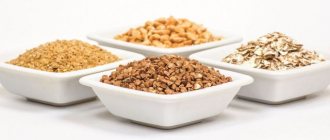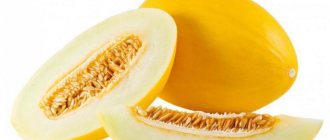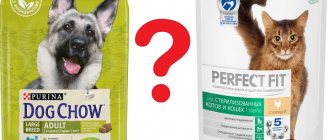The diet of four-legged pets is significantly different from the food consumed by humans. If the dog eats natural products rather than food, the owners often have a number of questions related to the preparation procedure. One of them is whether dogs need to salt their food when cooking. This issue requires detailed consideration, since salt can be both harmful and beneficial to health.
Salt is equally harmful and beneficial for a dog’s health.
The benefits and harms of salt for a dog's body
The most common choice for cooking food for dogs is table salt, which gives any dish a special taste, but can dogs eat salt? In small quantities, the component even brings benefits.
The component has a number of advantages:
- helps avoid dehydration;
- improves the functioning of blood vessels;
- normalizes heart rate;
- prevents the development of seizures;
- helps strengthen the skeleton;
- improves the functioning of the gastrointestinal tract.
However, regular consumption of salt can cause:
- diseases of the genitourinary system (cystitis, kidney stones);
- swelling;
- increased appetite.
Important! It is impossible to control the amount of salt a pet eats if the owner constantly feeds him food from his table.
Do not give your animal salty foods
Is it possible to give a dog salty food?
So can dogs have salt? Animals need it for comfortable digestion. But salty foods, such as chips, cheese, crackers, crackers and others, should not be given to your four-legged pet.
As for products that are salty by nature, for example, sea fish, when preparing it it is necessary to correctly calculate the dosage. Only ocean fish should be used as it is easier to digest.
Important! Excessive salt consumption inevitably leads to poisoning. In this case, not only dogs, but also cats, and indeed all animals, are at risk.
If you choose dog food for food, then it is best to limit your four-legged pet from using other salty foods, since such a product contains the necessary elements for proper development.
Should I salt food when cooking?
A pet can get the required amount of salt from fresh meat, fish and eggs, but what if it eats boiled foods. In this case, should dogs eat salt? After all, if you cook a product, the natural salt evaporates during the cooking process. This problem can be solved in the following way: when preparing food, you need to add 1/3 less of the ingredient than what a person adds to himself.
Important! When answering the question whether dogs need salt and whether dogs need salt when cooking, it should be noted that the crystals of this product should not be felt on the tongue.
It is necessary to control the pet's diet
What salt to use
Most often, when preparing food for a dog, owners choose table salt. It contains chlorine and sodium, which are necessary to maintain the health of your pet. Sea salt has beneficial properties. Compared to table food, it contains more beneficial microelements that are necessary for the dog’s health.
Important! If iodized salt is used, it is important to control its dosage when adding. Dogs suffering from thyroid diseases should not add it to their food.
There is another type - extra, consisting of small crystals. It is boiled down and contains fewer nutrients, so adding it to food is pointless.
What is salt?
Let's start with the reason why salt is added to pet food. Salt is a mineral made up of sodium and chlorine. In general, an adult dog's sodium requirement is approximately 200 mg, but a growing puppy may require up to 550 mg per day.
Required amount
The daily requirement for each animal is individual and it consists of the parameters of growth, age and body condition.
For a large pet, for example, if it is a Rottweiler, the daily norm is 1.7 g, and for small breeds - about 0.2 g. However, adding salt is required only if the diet does not contain products that contain this component, for example, sausages, sausages.
High salt content is detrimental to your pet's health
The benefits of salt
From a physiological point of view, the main functions of salt are that:
- It maintains fluid volume in the body.
- The sodium ions found in salt help in muscle contraction during the transmission of nerve impulses.
- Salt maintains blood pressure.
- Prevents conditions such as gout.
- Helps maintain normal blood pressure in the heart and kidneys.
The study, completed in 2008, aimed to study and determine the required sodium content in pet foods. It has been shown that increasing the amount of sodium in a pet's diet can increase urine excretion, making calcium oxalate (stones) less likely to form.
How to determine the lack and excess of salt in the diet
Due to lack of salt in the body, the dog is deprived of nutrients. Puppies occupy the leading position in the risk group. If they eat only bland food that is cooked, then over time they may develop developmental problems. The puppy becomes sickly, its physical performance decreases, and its health deteriorates. The lack of a component leads to apathy, refusal of any games and food. This also applies to adult dogs.
Important! If you add salt to food and offer it to your pet, a change in mood occurs right before your eyes.
Excessive salt content in the body can be determined by the following signs:
- Drink plenty of fluids. The dog suffers from thirst, regardless of weather conditions and physical activity.
- Frequent urination. The color of urine in this case is lighter than usual.
- Swelling. Swelling is especially noticeable on the face and paws.
- Problems with the gastrointestinal tract. Diarrhea and vomiting are observed.
- High fatigue. The dog's heart rate increases and there are signs of oxygen starvation.
- Neurological seizures. In this case, epilepsy attacks are meant.
Note! If excess salt is corrected with a special therapeutic diet, its consequences may affect the condition of the kidneys.
When is salt deadly?
It is not for nothing that sodium chloride is popularly called “white death” . Quite often, even a small amount in animal feed can be extremely dangerous.
You will have to avoid salt-containing foods if your dog has problems with:
- Stomach . Ulcers, gastritis, and other mucosal lesions react poorly even to small amounts in food.
- With my heart . In this case, heart failure and myocarditis are especially dangerous.
- Vessels . Atherosclerosis and hypertension, which occur in older decorative dogs, are a serious indication for a very strict diet.
- Painful joints and bones.
- With kidneys . Stones or insufficiency often develop due to an overabundance of certain substances, including sodium chloride.
- Liver.
If problems are detected with at least one of these organs, it is necessary to consult a veterinarian about a special maintenance diet, since life expectancy and the development or remission of these diseases depend on the substances entering the body.
Symptoms of salt poisoning: what to do
According to statistics, 8 out of 10 dogs die from salt poisoning, and most often the owner is to blame. This is why it is so important to understand why dogs should not have salt, and also in what cases it can be added.
Salt poisoning can be identified by symptoms such as:
- sudden mood swings;
- refusal to eat;
- tremor;
- convulsions;
- dyspnea;
- unsteady gait;
- the desire to rest your head against a corner.
Important! If the owner detects at least one of the symptoms, this is a reason to immediately contact a veterinarian. An experienced doctor will tell you whether it is possible to add salt to dogs’ food and how to do it correctly, as well as what foods are allowed.
Before the veterinarian arrives, it is necessary to provide the animal with constant access to drinking water. If the animal cannot drink on its own, deep and abundant enemas through the mouth will be required. When the condition stabilizes, the veterinarian will prescribe a course for the dog, in which the pet will need to be given boiled starch jelly from flax seeds.
Salt poisoning requires veterinary assistance
Cases of poisoning
Sometimes dogs manage to steal salted fish, sausage or vegetables from the table. They quickly eat food without even tasting it. As a result, the animals' bodies are subjected to serious testing. After all, the lethal dose of salt for a pet weighing 25-30 kg is only 80 grams.
Symptoms of table salt poisoning are similar to the initial stage of rabies - foamy salivation, diarrhea, vomiting, tremors of the limbs. If urgent measures are not taken, the dog’s skin sensitivity disappears and paralysis develops.
To provide assistance, forcefully inject 5 ml of vegetable oil into the dog’s mouth with a syringe. Then, every hour, give your pet water, strong iced tea, and milk. For the next two days, do not feed your dog any solid food. After the veterinarian's permission, you can switch to soups, vegetable purees, and food for weakened animals.
Basic rules for using salt in a dog's diet
Salt is the most important product for an animal. It takes part in the creation of blood, promotes the functioning of the stomach, and also affects appetite.
In order not to harm the health of your four-legged friend, food should be prepared with the amount of salt that is acceptable for the specific type of breed. In this case, it is especially important to carefully prepare your pet’s diet, which will include porridge and other healthy dishes.
On a note! Not only should salt be added in limited quantities, sugar also requires moderation when added to the diet.
It is important to review the amount of salt in an animal’s diet if it eats salty foods. Adding the product to food is strictly prohibited if the dog is sick. For such pets, it is worth choosing a competent diet together with your veterinarian.
The parameters of the animal should be taken into account when adding salt to its food.
When asked whether dogs can salt their food, the answer is yes. However, it is important to remember that the component will only be beneficial if added in moderation, since oversaturation often leads to disastrous consequences.
Is it possible to salt food for a dog?
It was already mentioned above that without salt the human body will be in trouble.
Similarly, dogs also need sodium chloride in small quantities to prevent dehydration, hematopoiesis problems and heart rhythm disturbances, the development of seizures, brittle bones and digestive disorders. But if salt has so many benefits, then why do almost all articles on dog nutrition say: “Salt is poison for animals”? This opinion is widespread, because not every owner will calculate how much salt enters the pet’s body with food, but the same food cheese or, for example, sea fish and meat already contains it. That is, it is quite difficult to determine on your own how much salt should be in dog dishes. So is it worth depriving your dog of the most important source of sodium? No, it’s not worth it, you can and should add a little salt to your food, but be sure to take into account what foods your pet eats. If his menu contains a lot of things that contain sodium (chicken eggs, milk, cattle meat, seafood, etc.), then salt is required, but very little. If the animal regularly eats sausage, sausages, canned fish, homemade borscht, soups, cutlets, then in this case it is better to refuse salt, since all the mentioned products are usually moderately salted, and sometimes over-salted.
Above we talked about the need for salt in the diet of a dog accustomed to a natural diet. Do dogs need salt in their food if they are accustomed to industrial food? The answer is clear: dogs eating ready-made dry or wet food do not need salt, since it is already contained in these products. Even high-quality extra-premium foods contain salt, and cheap economy-class foods generally contain it in excess.











